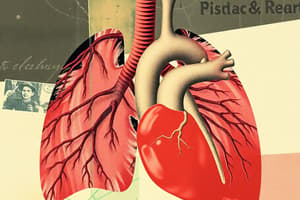Podcast
Questions and Answers
A blood sample taken from a patient shows abnormally low oxygen levels as it enters the left atrium. Which of the following pathways is most likely to be impaired?
A blood sample taken from a patient shows abnormally low oxygen levels as it enters the left atrium. Which of the following pathways is most likely to be impaired?
- Tricuspid valve to right ventricle
- Right ventricle to pulmonary valve
- Pulmonary veins to left atrium (correct)
- Vena cava to right atrium
A doctor discovers a patient's bicuspid valve is significantly narrowed, a condition called stenosis. How would this condition primarily affect blood flow?
A doctor discovers a patient's bicuspid valve is significantly narrowed, a condition called stenosis. How would this condition primarily affect blood flow?
- Increased flow from the left atrium to the left ventricle
- Reduced flow from the left atrium to the left ventricle (correct)
- Reduced flow from the right atrium to the right ventricle
- Increased flow from the right atrium to the right ventricle
If the pulmonary valve were unable to close properly, allowing backflow of blood, where would the blood be flowing back towards?
If the pulmonary valve were unable to close properly, allowing backflow of blood, where would the blood be flowing back towards?
- The pulmonary trunk
- The aorta
- The left ventricle
- The right ventricle (correct)
During a heart examination, a medical student detects a murmur associated with the tricuspid valve. This murmur is most likely due to:
During a heart examination, a medical student detects a murmur associated with the tricuspid valve. This murmur is most likely due to:
Which sequence correctly traces a drop of blood from the right atrium to the aorta?
Which sequence correctly traces a drop of blood from the right atrium to the aorta?
Flashcards
Initial Blood Flow Path
Initial Blood Flow Path
From vena cava to right atrium, through the tricuspid valve to the right ventricle.
Path to the Lungs
Path to the Lungs
From the right ventricle through the pulmonary valve to the pulmonary trunk, then to the lungs via pulmonary arteries.
Return from Lungs
Return from Lungs
From the lungs through the pulmonary veins to the left atrium.
Left Side Flow
Left Side Flow
Signup and view all the flashcards
Path to the Body
Path to the Body
Signup and view all the flashcards
Study Notes
- Blood moves from the vena cavae to the right atrium.
- Blood flows through the tricuspid valve into the right ventricle.
- Blood then goes through the pulmonary valve to the pulmonary truck.
- Blood goes to the pulmonary arteries towards the lungs.
- Blood returns from the lungs through the pulmonary veins.
- Blood flows into the left atrium.
- Blood moves through the bicuspid valve, to the left ventricle.
- Blood then goes through the arotic valve, to the rest of the body.
Studying That Suits You
Use AI to generate personalized quizzes and flashcards to suit your learning preferences.
Related Documents
Description
This lesson describes the flow of blood through the heart. Deoxygenated blood enters the heart through the vena cavae, travels to the lungs for oxygenation, and then returns to the heart to be pumped out to the rest of the body. Oxygenated blood exits through the aorta.




